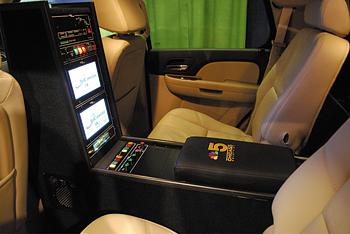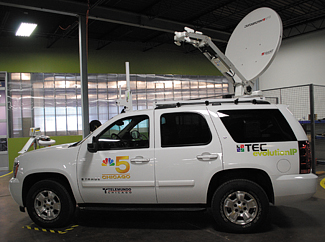Expanding ENG Capabilities via IP
SEATTLE There's a new technology acronym buzzing around the broadcast television business: IP ENG. In simple terms, it's bringing Internet Protocol (IP) capability into a station's electronic newsgathering operation.
Customers know that they want IP capabilities in the truck, that such IP applications are coming, but usually don't have any specific requests, according to van makers.
"They're just sure that they need to have it, as everything in the truck becomes IP addressable," said Rex Reed, director of business product development at E-N-G Mobile Systems in Concord, Calif. "Their requests are: 'Don't leave me hanging where I can't do that.'"

WMAQ-TV's new ENG van provides a 4.5 Mbps or 8 Mbps uplink and a bidirectional connection necessary for IP. That seems to boil down to three broad areas: file transfer, remote control and communication.
PRODUCTION SUITE ON WHEELS
"The vans we're building today are starting to resemble a little more of a small production or editing suite out on the road," said Fred Gerling, president of Gerling Associates in Subury, Ohio. Driver and passenger seats, for example are designed to swivel around to a laptop console where they can edit new story packages in the field.
In an IP-enabled van, once edited, these packages can not only be sent back via the standard satellite or terrestrial microwave link, but by IP paths such as public network WiFi, WiMAX, cellular and other connections. Because there may be no need for the package to go back to the studios in real-time (a one minute package transmitted in one minute), lower bandwidth networks can still transfer high-quality, high-definition video, though it make take some time to do so.
"I can see, eventually, where there will be certainly a fair amount of news from those trucks that are being sent back to a wireless node somewhere, rather than just through a satellite or through a full bandwidth microwave signal," said Ron Crockett, president of Shook USA in Schertz, Texas.
Crockett and others cautioned that liveshots using some of these IP paths might require stations to loosen their standards for "broadcast quality" video. Mixing the material with other standard definition video might be fine, where mixing it with HD video "might be a problem, because it just won't have that resolution," Crockett said.
The need to transfer files is not necessarily a one-way situation. When editing a package in the field, an editor connected via IP to the station could access video from the archives, or from another IP-connected ENG van at another location, to enhance the news package. Scripts and research material could also be accessed into the field.
Remote control of ENG vehicles has long been a "Holy Grail" for broadcasters looking to cut their operating budgets. IP-enabled equipment in the van can provide exactly that capability. "[It] gives broadcasters the opportunity to create much greater levels of automation and remote control of the ENG vehicles from the central site," said Ben McLeod, vice president of marketing at Micro-wave Radio Communications in North Billerica, Mass.
"Where IP is going to come into play in microwave is for bidirection control," said Tom Jennings, director of broadcast sales at Wolf Coach in Ayer, Mass. "As stations migrate towards being able to control transmission and/or all the basic functions of an ENG truck remotely from the station, rather than putting that in the hands of the operator [in the truck], you'll probably see migration to IP microwave."

Television Equipment Corporation (TEC) worked with Clear Channel Satellite data service to build a 1.2 meter dish truck for WMAQ-TV in Chicago that also features IP capability. While none of the van builders said they'd seen such remote control yet, remote control vendors are offering products with IP control capabilities.
Communication, the third IP category in the ENG van, has several facets. A news vehicle connected to the studios via IP can have access to the station's own Ethernet network, allowing the operator to check and send e-mail and perform other tasks they could complete at a computer terminal at the station itself. IP connected vehicles can communicate with one another.
Other communication equipment can also be enabled into the field via IP, such as connection into the station's intercom system.
Intercom vendor Clear-Com is just bringing its IP-based Concert intercom system to market. "Then anywhere you've got a laptop [connected via IP]," said Jake Dodson, vice president of product management at Clear-Com, "that laptop [intercom station] has access to anybody else who's on the Concert server."
SEVERAL PATHS
Where an ENG truck sending a video signal back via microwave is a one-way path, IP connectivity requires a bidirectional hookup. The path one direction takes does not have to be the same as the return path. There are a number of different ways to make that IP connection.
While it was, and still is, possible to send IP data over an analog microwave link, the arrival of digital microwave has simplified inserting IP into spare bandwidth in the microwave signal.
Broadcast Microwave Services , Global Microwave Systems, MRC, Nucomm and RF Central are among the companies manufacturing microwave radios capable of IP operation.
For a return path back out to the ENG truck(s), the station's DTV signal can be utilized. The IP data can be inserted into spare bandwidth in the 6 MHz ATSC signal, where it can be extracted from the digital signal at the remote site.
While the broadcaster owns and controls his microwave path and ATSC channel, there are a plethora of other options for field connectivity out there, with more appearing all the time. These include the WiFi, WiMAX and cellular connectivity previously mentioned. One downside to these services, however is that as more users are connected at a particular location, the service for each individual user slows down.
Additionally, such services are designed backwards from the standpoint of a broadcaster's needs. That's because they provide robust download bandwidth, but minimal upload speed. This may be ideal for the coffee shop laptop user who sends very little data from his computer, but not very helpful to a news crew pushing a large video file back to the station. (Forget trying to use that connection to go live without looking like a war correspondent in the desert.)
There is at least one case, however, where a station, KIFI-TV in Idaho Falls, made arrangements with its WiMAX provider to guarantee their uplink speed will be at least 2 Mbps, which the station said provides a good live SD video signal from the field. ["'WING'-ing It for ENG," TV Technology, Aug. 6].
Though it hadn't yet been delivered to Chicago CBS affiliate WMAQ-TV at presstime, Television Equipment Corporation (TEC) in St. Louis, worked with Clear Channel Satellite data service to build a truck utilizing a 1.2 meter dish. The Clear Channel service provides the ability to do a 4.5 Mbps or 8 Mbps uplink, and supplies the bidirectional connection necessary for IP. The service is on a monthly subscription basis.
FUTURE PROOF
So what are customers to do to future-proof themselves for what's coming in IP ENG? "I think a lot of the folks are relying on us to provide viable solutions that meet what the end client need is," said Brad Gleason, director of new vehicle sales at TEC.
One way van builders are preparing ENG vans for IP is to run CAT-5 Ethernet cabling around and through the vehicle during the construction process, while it's easy to do so, much the same way they often run extra audio and video cable through the van, just in case.
One vendor said he's even run CAT-5 through the NyCoil (the coiled conduit used to house electrical wiring or antenna RF cable that extends as the mast telescopes). The vendor admitted he doesn't know what it might eventually connect to.
"I would say probably about 30-40 percent of the vehicles that we're delivering now have some sort of remote LAN network installed in the truck," said Gary Britt, director of sales engineering at Clearwater, Fla.-based Frontline Communications. A switchable router connects to all the devices that have an Ethernet port on them. "Some are going the next step and attaching a cable modem, EVDO modem, so that they have Internet access to the computers within the truck," Britt said.
With multiple interfaces in an ENG van providing different methods of IP connectivity, several vendors have come up with intelligent media routers to automate these connections.
A typical example is Nucomm's Messenger, which "not only takes care of sending the traffic through these individual interfaces, but it manages and switches between [them] dynamically as those interfaces come up or down, and automatically routes the traffic through those interfaces," said John Payne IV, Nucomm vice president of engineering.
Get the TV Tech Newsletter
The professional video industry's #1 source for news, trends and product and tech information. Sign up below.
